Medieval History
 I first picked up Professor Eamon Duffy's Stripping of the Altars when I was an undergraduate reading History at University College London. It was the mid 90's and the revisionist view of the Reformation had really begun to take a firm hold in Tudor scholarship. I remember just lapping up this compelling and refreshing account of the popularity of late medieval religion and the sad and distructive dismantling of that popular catholicism. It was great to read a book, a work of substantial scholarship, that not only accorded with something of my romantic vision of the compelling nature of medieval catholicism, but wasn't coloured by four centuries of Protestant and anti-Catholic propoganda. It still remains one of my all time favourite books.
I first picked up Professor Eamon Duffy's Stripping of the Altars when I was an undergraduate reading History at University College London. It was the mid 90's and the revisionist view of the Reformation had really begun to take a firm hold in Tudor scholarship. I remember just lapping up this compelling and refreshing account of the popularity of late medieval religion and the sad and distructive dismantling of that popular catholicism. It was great to read a book, a work of substantial scholarship, that not only accorded with something of my romantic vision of the compelling nature of medieval catholicism, but wasn't coloured by four centuries of Protestant and anti-Catholic propoganda. It still remains one of my all time favourite books.
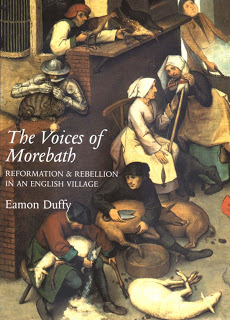 The sequel, if you like, to the Stripping of the Altars, is a book called The Voices of Morebath, which was first published out in 2001.This is the account of the impact of the Tudor Reformation on a small parish on Exmoor in Devon, seen through the lense of the parish churchwarden's accounts. The accounts were kept by a man called Sir Christopher Trychay, who would serve as vicar of Morebath for fifty four years. He was vicar all through the period of turmoil, arriving in 1520 as a young fresh-faced catholic priest and dying in post in his eighties, as the protestant minister. The accounts are not just a list of expenses of office, Trychay overlayed them with his own commentary and asides, which provide ga rare glimpse of parish life in the Tudor period.
The sequel, if you like, to the Stripping of the Altars, is a book called The Voices of Morebath, which was first published out in 2001.This is the account of the impact of the Tudor Reformation on a small parish on Exmoor in Devon, seen through the lense of the parish churchwarden's accounts. The accounts were kept by a man called Sir Christopher Trychay, who would serve as vicar of Morebath for fifty four years. He was vicar all through the period of turmoil, arriving in 1520 as a young fresh-faced catholic priest and dying in post in his eighties, as the protestant minister. The accounts are not just a list of expenses of office, Trychay overlayed them with his own commentary and asides, which provide ga rare glimpse of parish life in the Tudor period.
During the first twenty years of his ministry Trychay put a good deal of effort into re-enlivening the devotional life of this remote parish. He fostered the development a cult to the Exeter saint St Sidwell, which was focused on an image of her that he placed on the side altar in the north aisle. Together he and the parishioners worked towards a thorough restoration and requipping of the church building. Work included a new rood screen, a new rood and the renovation of all the images. Duffy tells us that all was done with love and great devotion. One of the most compelling and heartbreaking details of the account concerns a set of new black vestments. For twenty years Trychay had saved up for a new set of black vestments for use at requiems, putting his own money into the fund and in July 1547 he finally raised enough money to get them. However, Henry VIII had died earlier in 1547 and his death signalled the first phase of the Protestant Reformation and all the vestments and ornaments so lovingly bought, including the new black vestments, were soon to be swept away for ever.
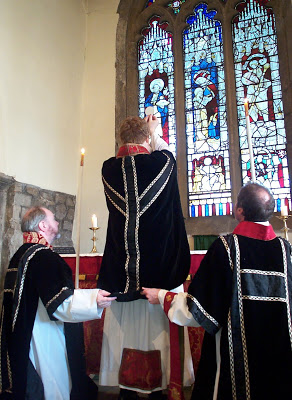 What for me is so compelling and moving about Duffy's book is what it tells us of Trychay's attitude to the Reformation. Throughout the uncertain years that followed, with the demands of reform and counter reform, Trychay stays faithful to his parishioners. He doesn't resign his living, he stays put and weathers the storm with them. He is quietly nonconformist when he can be and equally conformist when need arises. There is a sense that his loyalty to his people and their place overides his own personal conviction - his thoughts and actions are always corporate, never individual. Duffy lays bare the odd contemporary assertion, which has been voiced by commentars of this blog, that the church buildings of medieval England were somehow stolen from the Catholic church and handed to the robbing Protestants of the Church of England in a grand coup. Duffy makes it plain that this is not so. In the reign of Elizabeth, the priest saying the communion service at the table was often the same priest who had said mass at the altar during the reigns of her father and sister. The people responding to the new service of Matins and Evensong, were the same people who would eagerly see Our Lord lifted high above the priest's head at the altar during mass. For the most part the people of England, both the clergy and the people, quietly conformed to the demands of the Reformation. Priests like Trychay, inwardly conservative in religious matters, outwardly conformed and they stayed faithful and loyal to their flock. What else could they do?
What for me is so compelling and moving about Duffy's book is what it tells us of Trychay's attitude to the Reformation. Throughout the uncertain years that followed, with the demands of reform and counter reform, Trychay stays faithful to his parishioners. He doesn't resign his living, he stays put and weathers the storm with them. He is quietly nonconformist when he can be and equally conformist when need arises. There is a sense that his loyalty to his people and their place overides his own personal conviction - his thoughts and actions are always corporate, never individual. Duffy lays bare the odd contemporary assertion, which has been voiced by commentars of this blog, that the church buildings of medieval England were somehow stolen from the Catholic church and handed to the robbing Protestants of the Church of England in a grand coup. Duffy makes it plain that this is not so. In the reign of Elizabeth, the priest saying the communion service at the table was often the same priest who had said mass at the altar during the reigns of her father and sister. The people responding to the new service of Matins and Evensong, were the same people who would eagerly see Our Lord lifted high above the priest's head at the altar during mass. For the most part the people of England, both the clergy and the people, quietly conformed to the demands of the Reformation. Priests like Trychay, inwardly conservative in religious matters, outwardly conformed and they stayed faithful and loyal to their flock. What else could they do?
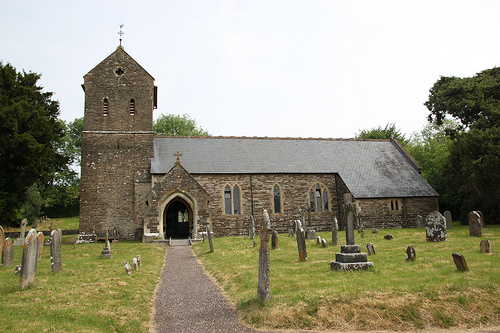
I was very pleased to be able to visit Morebath last week and below are one or two photos of the church. Sadly much of the church was rebuilt by William Butterfield in the 1870s and the only part that Trychay would recognise is the fifteenth century north aisle with its barrel roof. It was at the east end of this aisle at the altar of Jesus that Trychay placed the new cultic image of St Sidwell and it was here that he said his daily mass, while he could. Of course all sign of that altar has been swept away.
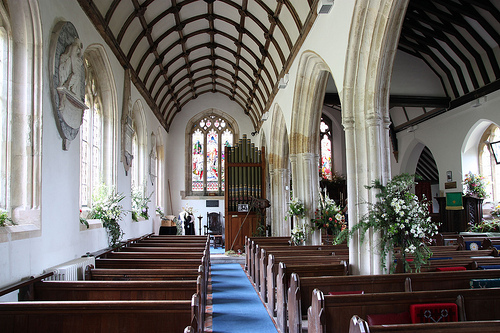
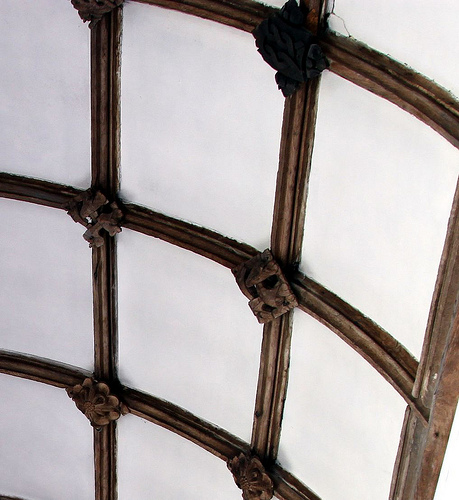
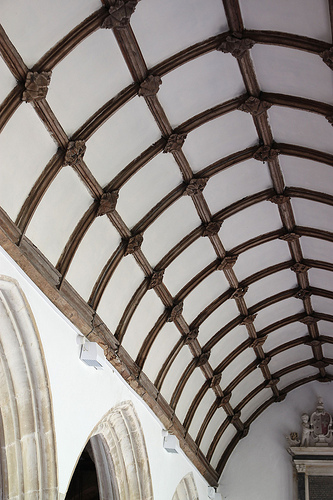
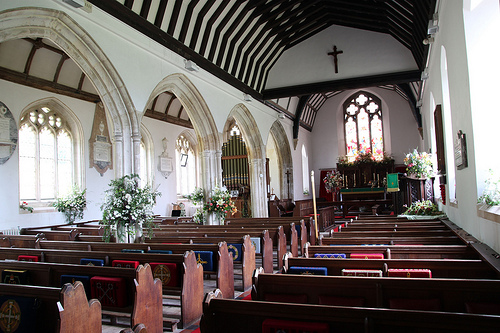
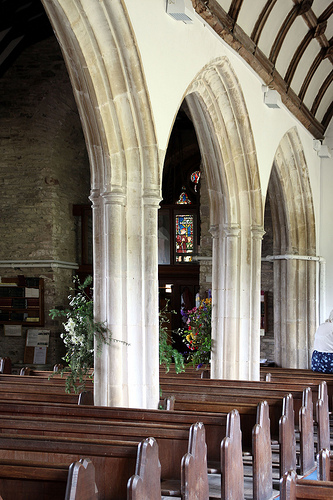
- 2015 Deerhurst Lecture
The 2015 Deerhurst Lecture will take place on Saturday 12th September 2015 at 7.30 pm at St Mary?s Church, Deerhurst, Gloucestershire. Normally the lecture is given on a topic concerning the early medieval period, but this year we are venturing...
- Author Interviews Coming To Ancient & Medieval Mayhem Blog In June
ROBYN YOUNGInterview with Author, Robyn Young. In early June to kick off the Ancient & Medieval Historical Fiction Group's Medieval Group Read of Insurrection. ...
- The Lyng Table Carpet
One of the most tragic losses of the Reformation was undoubtedly the destruction of fine ecclesiastical textiles. Many thousands of vestments were confiscated and destroyed during the reign of Edward VI and many others were taken...
- Lenten Array 2011
The ancient western custom of covering altars and images with Lenten array and Lenten veils has been covered on this blog a number of times. If you want to know more about the custom and its purpose look at the article here and...
- How's This For A Bit Of Atmosphere
A fifteenth century Seven Sacrament font in Ham stone, sandstone recesses with thirteenth and fourteenth century effigies of the Ralegh family, a late medieval waggon roof, a patchwork of old flooring and a late seventeenth century tablet...
Medieval History
In search of Morebath


During the first twenty years of his ministry Trychay put a good deal of effort into re-enlivening the devotional life of this remote parish. He fostered the development a cult to the Exeter saint St Sidwell, which was focused on an image of her that he placed on the side altar in the north aisle. Together he and the parishioners worked towards a thorough restoration and requipping of the church building. Work included a new rood screen, a new rood and the renovation of all the images. Duffy tells us that all was done with love and great devotion. One of the most compelling and heartbreaking details of the account concerns a set of new black vestments. For twenty years Trychay had saved up for a new set of black vestments for use at requiems, putting his own money into the fund and in July 1547 he finally raised enough money to get them. However, Henry VIII had died earlier in 1547 and his death signalled the first phase of the Protestant Reformation and all the vestments and ornaments so lovingly bought, including the new black vestments, were soon to be swept away for ever.

I was very pleased to be able to visit Morebath last week and below are one or two photos of the church. Sadly much of the church was rebuilt by William Butterfield in the 1870s and the only part that Trychay would recognise is the fifteenth century north aisle with its barrel roof. It was at the east end of this aisle at the altar of Jesus that Trychay placed the new cultic image of St Sidwell and it was here that he said his daily mass, while he could. Of course all sign of that altar has been swept away.





- 2015 Deerhurst Lecture
The 2015 Deerhurst Lecture will take place on Saturday 12th September 2015 at 7.30 pm at St Mary?s Church, Deerhurst, Gloucestershire. Normally the lecture is given on a topic concerning the early medieval period, but this year we are venturing...
- Author Interviews Coming To Ancient & Medieval Mayhem Blog In June
ROBYN YOUNGInterview with Author, Robyn Young. In early June to kick off the Ancient & Medieval Historical Fiction Group's Medieval Group Read of Insurrection. ...
- The Lyng Table Carpet
One of the most tragic losses of the Reformation was undoubtedly the destruction of fine ecclesiastical textiles. Many thousands of vestments were confiscated and destroyed during the reign of Edward VI and many others were taken...
- Lenten Array 2011
The ancient western custom of covering altars and images with Lenten array and Lenten veils has been covered on this blog a number of times. If you want to know more about the custom and its purpose look at the article here and...
- How's This For A Bit Of Atmosphere
A fifteenth century Seven Sacrament font in Ham stone, sandstone recesses with thirteenth and fourteenth century effigies of the Ralegh family, a late medieval waggon roof, a patchwork of old flooring and a late seventeenth century tablet...
